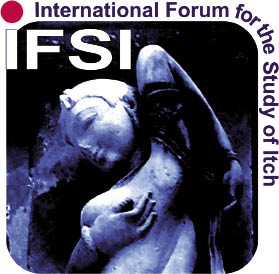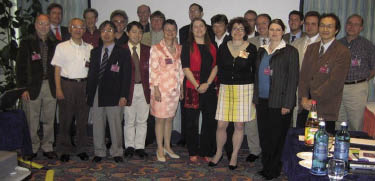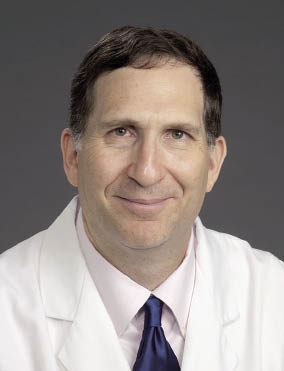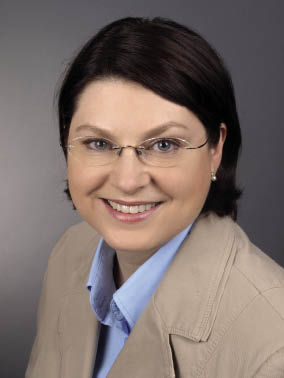THEME ISSUE:
ATOPIC DERMATITIS, URTICARIA AND ITCH
THEME ISSUE:
ATOPIC DERMATITIS, URTICARIA AND ITCH
“Reading the Itch”: A Successful Cooperation Between the International Forum for the Study of Itch (IFSI) and Acta Dermato-Venereologica
About the International Forum for the Study of Itch

Official logo of IFSI.
The International Forum for the Study of Itch (IFSI; www.itchforum.net) is a multidisciplinary international association dedicated to improving the understanding and treatment of acute and chronic itch for the benefit of patients worldwide. IFSI is open to clinicians, researchers, scientists and other health professionals engaged in research into, and treatment of, itch. The main aims of this non-profit organization are to advance itch-related research and education and to promote treatment and clinical efforts to help alleviate this debilitating symptom. The current goal of IFSI is to create an active society that successfully contributes to experimental and clinical studies on itch. IFSI also disseminates new information about itch to its members, the international medical community and the public through various media. Through Special Interest Groups (SIG) the society focuses on unresolved clinical problems in order to provide new definitions and tools to assess pruritus.
The society was founded in September 2005 in Heidelberg, Germany during the 3rd International Workshop for the Study of Itch (Fig. 1). Professor Gil Yosipovitch (Winston Salem, NC, USA) (Fig. 2) was elected the first president of IFSI, followed by Professor Sonja Ständer (Münster, Germany) (Fig. 3), who served as president from 2007 to 2011. The society is currently lead by Professor Jacek C. Szepietowski (Wroclaw, Poland), president; Professor Earl Carstens (Davis, CA, USA), vice-president; Professor Elke Weisshaar (Heidelberg, Germany), secretary general; and Professor Alan Fleischer (Winston Salem, NC, USA), treasurer. In 2010 IFSI joined the International League of Dermatological Societies (ILDS). IFSI is still a young society, but is a rapidly growing one. In 2010 we exceeded 100 members, who represent 21 countries in Europe, Asia, North and South America and Africa.
Fig. 1. The 21 founding members of the International Forum for the Study of Itch (IFSI) (25 September 2005).


Fig. 2. Prof. Gil Yosipovich (Winston-Salem, USA), President of IFSI from 2005 to 2007.

Fig. 3. Prof. Sonja Ständer (Münster, Germany), President of IFSI from 2007 to 2011.
Immediately after the society’s foundation IFSI initiated several projects. The first was the creation of a classification of itch. The clinical classification of itch was published in 2007 (1) and was accepted worldwide. As IFSI members contribute to the World Health Organization (WHO) project on International Classification of Diseases 11th Revision (ICD-11), the IFSI itch classification was preliminarily incorporated into ICD-11. Members are currently working within 3 SIG, on scoring itch in clinical trials, development of an international itch questionnaire, and paraneoplastic pruritus. IFSI is also contributing significantly to the first course on itch, which is organized by the European Academy of Dermatology and Venereology (EADV) for residents in dermatology (Brussels, June 2012). IFSI conducts international meetings every second year, which are open to researchers and clinicians (Table I). The first workshop on itch was organized in 2001, before the official foundation of IFSI. Until 2010 the meeting was entitled „International Workshop for the Study of Itch“, and in 2010 this was changed to „World Congress on Itch (WCI)“. The next meeting, the 7th World Congress on Itch, will be held in Boston, USA on 21–23 September 2013.
Table I. World Congresses on Itch (entitled “International Workshop for the Study of Itch” until 2010)
|
Year |
Continent |
Location |
Principal organizer |
|
2001 |
Asia |
Singapore |
Gil Yosipovitch |
|
2003 |
Asia |
Toyama, Japan |
Yasushi Kuraishi |
|
2005 |
Europe |
Heidelberg, Germany |
Elke Weisshaar |
|
2007 |
North America |
San Francisco, USA |
Earl Carstens |
|
2009 |
Asia |
Tokyo, Japan |
Kenji Takamori |
|
2011 |
Europe |
Brest, France |
Laurent Misery |
|
2013* |
North America |
Boston, USA |
Ethan Lerner |
|
2015* |
Asia |
Fukuoka, Japan |
Masutaka Furue |
*Accepted future congresses.
IFSI and Acta Dermato-Venereologica
Acta Dermato-Venereologica has been the official journal of IFSI since 2007, when an “Itch Section”, with IFSI members acting as section editors, was established (2). Acta Dermato-Venereologica is the first journal worldwide with a dedicated section for papers dealing clinically or experimentally with itch. IFSI is proud that among the top 5 most viewed articles there are 2 papers by IFSI members (1, 3) as well as the abstracts of 1 of the previous IFSI meetings (www.medicaljournals.se/acta).
This issue of Acta Dermato-Venereologica includes a grouped selection of very interesting papers dealing with the epidemiology, pathogenesis, consequences and therapy of itch. Some of these papers were officially prepared on behalf of IFSI SIG. The article by Weisshaar et al. (4) describes expectations of the optimum itch questionnaire and provides guidance to its development. There are 2 articles on the validation of the visual analogue scale for assessment of itch (5, 6). For the first time cut-off points are suggested in assessing the intensity of itch using this scale. We draw your attention to the guidelines on chronic pruritus (7), which will be a useful instrument for many practitioners in their daily work. To the best of our knowledge these are the first pan-European guidelines setting out a treatment algorithm for chronic itch. These recommendations were prepared according to the European rules for creation of therapeutic guidelines in cooperation with European Dermatology Forum and EADV. The majority of experts are IFSI members.
The authors would like to thank Acta Dermato-Venereologica for providing us with a platform specifically dedicated to research into itch.
We hope you enjoy reading about itch in Acta Dermato-Venereologica!
REFERENCES
Jacek C. Szepietowski1 and Sonja Ständer2
1Department of Dermatology, Venereology and Allergology, Wroclaw Medical Unieversity, Chalubinskiego 1, 50-368 Wroclaw, Poland, and 2Clinical Neurodermatology, Department of Dermatology, University Hospital of Münster, Münster, Germany. E-mail: jacek.szepietowski@am.wroc.pl
